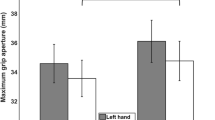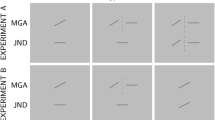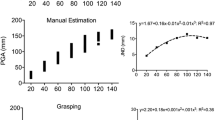Abstract
Previous studies in our lab have described kinematic difference between grasp-to-eat and grasp-to-place movements, whereby participants produce smaller maximum grip apertures (MGAs) when grasping to bring the item to the mouth than when grasping to bring the item to a container near the mouth. This task difference is limited to right-handed movements, regardless of handedness; it has, therefore, been interpreted as evidence of left-hemisphere lateralization of the grasp-to-eat and other hand-to-mouth grasping movements. However, the difference in end-goal aperture may have accounted for both the kinematic signature (smaller MGAs) and their lateralized expression. Specifically, if the right hand is more sensitive to the precision requirements of secondary movements, it may have produced more precise MGAs for actions whose ultimate goal is the small-aperture mouth rather than a comparatively large aperture container. The current study addresses this question by replacing the previously-used bib with a small drinking glass whose aperture more closely resembles that of the mouth. 25 adult participants reached-to-grasp small cereal items to either (a) eat them, or (b) place them into a small-aperture glass hanging beneath their chin. Results once more showed a lateralised kinematic signature in the form of smaller MGAs for the eat action, demonstrating that the signature is not a result of lateralized sensitivity to a movement’s secondary precision requirements. We discuss these results in terms of their impact on predominant theories regarding visual guidance of grasping movements.


Similar content being viewed by others
Notes
In previous manuscripts, we have referred to this task-dependent effect as a kinematic advantage, as peak grip closing velocity, grip closing time, and metabolic energy requirements are reduced when MGA more closely matches absolute target size (Bootsma et al. 1994). However, larger maximum grip apertures may also represent a kinematic advantage; for example, larger MGAs result in an increased margin for error, and may improve the odds for successful target capture in cases of target uncertainty (Jakobson and Goodale 1991). In the absence of empirical data that would irrefutably support our use of the word advantage, we will instead use the broader expression of ‘kinematic signature’ to refer to the effect in question.
References
Annett M (1967) The binomial distribution of right, mixed and left handedness. Q J Exp Psychol 19(4):327–333
Armbrüster C, Spijkers W (2006) Movement planning in prehension: do intended actions influence the initial reach and grasp movement? Motor Control 10(4):311
Begliomini C, Nelini C, Caria A, Grodd W, Castiello U (2008) Cortical activations in humans grasp-related areas depend on hand used and handedness. PLoS One, 3(10), e3388. http://www.ncbi.nlm.nih.gov/pmc/articles/PMC2561002/pdf/pone.0003388.pdf
Bootsma RJ, Marteniuk RG, MacKenzie CL, Zaal F (1994) The speed-accuracy trade-off in manual prehension: effects of movement amplitude, object size, and object width on kinematic characteristics. Exp Brain Res 98:535–541
Cavill S, Bryden P (2003) Development of handedness: comparison of questionnaire and performance-based measures of preference. Brain Cogn 53(2):149–151
Chieffi S, Gentilucci M (1993) Coordination between the transport and the grasp components during prehension movements. Exp Brain Res 94(3):471–477
Cooper S, Doan J, Pellis S, Whishaw I, Brown L (2005) Reducing stability of support structure for a target does not alter reach kinematics among younger adults. Percept Mot Skills 100(3):831–838
Ferri F, Campione GC, Dalla Volta R, Gianelli C, Gentilucci M (2010) To me or to you? When the self is advantaged. Expl Brain Res 203(4):637–646. http://download.springer.com/static/pdf/44/art%253A10.1007%252Fs00221-010-2271-x.pdf?auth66=1380232878_62cfc7b7035886a80611d26558c83aac&ext=.pdf
Fitts PM (1954) The information capacity of the human motor system in controlling the amplitude of movement. J Exp Psychol 47:381–391
Flindall JW (2012) Manual asymmetries in the kinematics of reach-to-grasp actions. (Master of Science), University of Lethbridge, Lethbridge
Flindall JW, Gonzalez C (2013) On the evolution of handedness: evidence for feeding biases. PLoS One 8(11):e78967
Flindall JW, Gonzalez C (2014) Eating interrupted: the effect of intent on hand-to-mouth actions. J Neurophysiol 112(8):2019–2025
Flindall JW, Gonzalez C (2015) Children’s bilateral advantage for grasp-to-eat actions becomes unimanual by age 10 years. J Exp Child Psychol 133:57–71
Flindall JW, Gonzalez C (2016) The destination defines the journey: an examination of the kinematics of hand-to-mouth movements. J Neurophysiol 116(5):2105–2113
Flindall JW, Doan JB, Gonzalez C (2014) Manual asymmetries in the kinematics of a reach-to-grasp action. Later Asymmetries Body Brain Cognit 19(4):489–507
Flindall JW, Stone K, Gonzalez C (2015) Evidence for right-hand feeding biases in a left-handed population. Later Asymmetries Body Brain Cognit 20(3):287–305
Franz VH, Hesse C, Kollath S (2007) Grasping after a delay: more ventral than dorsal? J Vis 7(9):article #157
Goodale M (2011) Transforming vision into action. Vis Res 51(13):1567–1587
Graziano MS (2006) The organization of behavioral repertoire in motor cortex. Annu Rev Neurosci 29:105–134
Graziano MS, Taylor CS, Moore T (2002) Complex movements evoked by microstimulation of precentral cortex. Neuron 34(5):841–851. http://ac.els-cdn.com/S0896627302006980/1-s2.0-S0896627302006980-main.pdf?_tid=272b9d8c-2565-11e3-9f31-00000aacb35d&acdnat=1380060393_a319c3c1619b4bd55aebd0a7057b9208
Graziano MS, Aflalo TN, Cooke DF (2005) Arm movements evoked by electrical stimulation in the motor cortex of monkeys. J Neurophysiol 94(6):4209–4223. http://jn.physiology.org/content/94/6/4209.full.pdf
Grosskopf A, Kuhtz-Buschbeck JP (2006) Grasping with the left and right hand: a kinematic study. Exp Brain Res 168:230–240
Hesse C, Franz VH (2010) Grasping remembered objects: exponential decay of the visual memory. Vis Res 50(24):2642–2650
Hu Y, Goodale M (2000) Grasping after a delay shifts size-scaling from absolute to relative metrics. J Conitive Neurosci 12(5):856–868
Hu Y, Eagleson R, Goodale M (1999) The effects of delay on the kinematics of grasping. Exp Brain Res 126:109–116
Jakobson L, Goodale M (1991) Factors affecting higher-order movement planning: a kinematic analysis of human prehension. Exp Brain Res 86:199–208
Jeannerod M (1984) The timing of natural prehension movements. J Mot Behav 16(3):235–254
Jeannerod M (1986) The formation of finger grip during prehension. a cortically mediated visuomotor pattern. Behav Brain Res 19(2):99–116. http://www.ncbi.nlm.nih.gov/pubmed/3964409
Kuhtz-Buschbeck J, Stolze H, Jöhnk K, Boczek-Funcke A, Illert M (1998) Development of prehension movements in children: a kinematic study. Exp Brain Res 122(4):424–432
Marteniuk RG, MacKenzie CL, Jeannerod M, Athenes S, Dugas C (1987) Constraints on human arm movement trajectories. Can J Psychol Revue Canadienne de Psychologie 41(3):365. http://graphics.tx.ovid.com/ovftpdfs/FPDDNCGCOAIDPG00/fs046/ovft/live/gv023/00002784/00002784-198709000-00007.pdf
Marteniuk RG, Leavitt JL, MacKenzie CL, Athenes S (1990) Functional relationships between grasp and transport components in a prehension task. Hum Mov Sci 9(2):149–176
Maruff P, Wilson P, De Fazio J, Cerritelli B, Hedt A, Currie J (1999) Asymmetries between dominant and non-dominanthands in real and imagined motor task performance. Neuropsychologia 37(3):379–384
Milner A, Goodale M (2008) Two visual systems re-viewed. Neuropsychologia 46(3):774–785
Oldfield RC (1971) The assessment and analysis of handedness: the Edinburgh inventory. Neuropsychologia 9:97–113
Olivier I, Hay L, Bard C, Fleury M (2007) Age-related differences in the reaching and grasping coordination in children: unimanual and bimanual tasks. Exp Brain Res 179(1):17–27
Sartori L, Straulino E, Castiello U (2011) How objects are grasped: the interplay between affordances and end-goals. PLoS One 6(9):e25203. http://www.ncbi.nlm.nih.gov/pmc/articles/PMC3182194/pdf/pone.0025203.pdf
Stone K, Bryant D, Gonzalez C (2013) Hand use for grasping in a bimanual task: evidence for different roles? Exp Brain Res 224(3):455–467. http://download.springer.com/static/pdf/829/art%253A10.1007%252Fs00221-012-3325-z.pdf?auth66=1395419957_da154861cf315bb4c78850b961d8607c&ext=.pdf
Tretriluxana J, Gordon J, Winstein CJ (2008) Manual asymmetries in grasp pre-shaping and transport-grasp coordination. Exp Brain Res 188:305–315
Whishaw IQ, Suchowersky O, Davis L, Sarna J, Metz GA, Pellis SM (2002) Impairment of pronation, supination, and body co-ordination in reach-to-grasp tasks in human Parkinson’s disease (PD) reveals homology to deficits in animal models. Behav Brain Res 133(2):165–176. http://ac.els-cdn.com/S016643280100479X/1-s2.0-S016643280100479X-main.pdf?_tid=8a631192-25ff-11e3-8adb-00000aab0f27&acdnat=1380126702_6e11baa1efb8f74322d9d9b531630ff1
Author information
Authors and Affiliations
Corresponding author
Rights and permissions
About this article
Cite this article
Flindall, J.W., Gonzalez, C.L.R. The inimitable mouth: task-dependent kinematic differences are independent of terminal precision. Exp Brain Res 235, 1945–1952 (2017). https://doi.org/10.1007/s00221-017-4943-2
Received:
Accepted:
Published:
Issue Date:
DOI: https://doi.org/10.1007/s00221-017-4943-2




